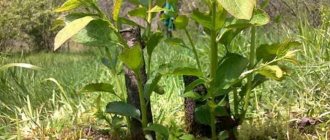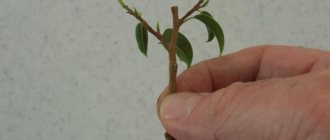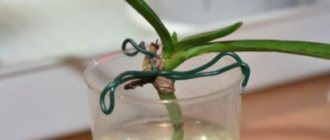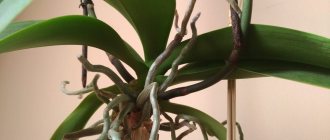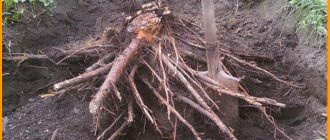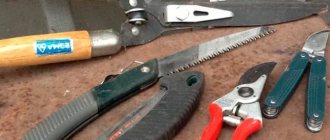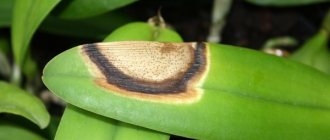Trees and shrubs
Anastasia Zemlyanichko 07/05/2018
3
( 23 ratings, average: 4.30 out of 5)
- 1 Methods for uprooting stumps
- 2 Using technology
- 3 Manual removal
- 4 Using chemicals
- 5 Biological method
At some point, every gardener or owner of a personal plot asks the question of how to uproot trees and stumps on a property. Uprooting trees is not an easy task, and the choice of method for removing roots depends on each individual case.
With the help of technology
This is perhaps the fastest way. The stump is pryed up with an excavator bucket and pulled out of the ground. In the case of a tree, its frame is tied with a cable and pulled out with the help of a tractor.
The speed of this method is perhaps the only advantage. There are many more disadvantages:
- Hiring equipment is quite expensive;
- Not every site can accommodate such large and heavy vehicles;
- When heavy equipment is used on a site, the top layer of soil is severely damaged; restoring the landscape will require a lot of time, effort and money. Is it worth spending so much money just for one stump?
This method is good if you need to clear a large space, for example, for construction or new plantings.
Stump remover
Special device for uprooting. Can be manual or mounted. A manual uprooter is used to remove young, thin trees and shrubs. Consists of a support platform and a stand with a lever and grip for wood.
- Advantages: carefully and quickly removes young growth without damaging the landscape.
- Disadvantages: it is impractical to buy for personal use for isolated cases, and to rent it you will also have to try - not every household has such a unit.
A mounted tree stump is mounted on heavy equipment and is designed to remove large numbers of stumps over a wide area.
Stump crushing machine
Self-propelled compact mechanism on wheels with a gasoline engine. Removes stumps by crushing wood to a depth of 30 cm. Suitable for removing single stumps among plantings or buildings. Among the advantages of the method are the speed of work, accuracy and safety - the surrounding landscape, buildings and communications are not damaged.
Disadvantages: the crushing depth is small, only 30 cm. This means that the roots remaining at depth in the future may produce unwanted growth or interfere with plowing the land and laying communications; the use of such equipment is possible only in areas free of various solid debris. The presence of metal objects (bolts, nails, fittings, etc.) in the ground is especially dangerous, as expensive equipment can be damaged.
Uprooting stumps using a winch
Mechanical root removal is another option that is suitable for removing small to medium sized young trees. To remove a tree in this way, it is necessary to carry out preliminary preparation, namely: dig around the object to be removed within a radius of 1 meter or a little more and to a depth of about half a meter, cut off the exposed lateral roots. Then the stump is tied at the base with a cable, and at a sufficient distance from it, a winch is attached to a reliable support, and the pulling process begins. Once the stump is removed, you can do the same to get rid of the roots remaining in the ground.
Advantages of the method: if the farm has the necessary tools (bayonet shovel, crowbar, axe, hacksaw, winch and strong cable), then the method is not expensive. It’s possible to cope on your own without the help of help.
Disadvantages: not every stump can be handled by a winch. It is unlikely to overcome a strong young tree, and even one growing in dense clay soil. Or there may simply not be a suitable object nearby to which it can be attached.
Chainsaw
She can also get rid of a stump without uprooting - the trunk is cut down at ground level. The method is fast and not expensive. It is good if you need to give the site an aesthetic appearance in a short time. But the disadvantages are obvious: only the above-ground part is removed, the remaining roots will give rise to shoots after some time. In addition, it is impossible to plow the ground in the place of the cut stump. And it is not recommended to start construction (remember about the growth).
Preparing to destroy tree roots
Before you begin removing roots, you should decide on the method you will use for this. Wood residues can be destroyed mechanically or chemically.
If you prefer to remove part of the trunk by hand, you will need a saw, shovel and axe. In this case, you will first have to dig a hole around the stump, chop or saw down its roots and gradually, piece by piece, remove the wood from the soil.
Note: The mechanical method is considered obsolete not only because of the high labor costs, but also because some large specimens are difficult to remove manually, and the remains can only be uprooted from the soil using machinery.
The chemical method is considered more modern. The remaining wood is simply treated with a special preparation that accelerates the process of fiber destruction. As a result, in a short time the remains of the trunk begin to crumble, and all you have to do is remove it.
Figure 1. Preparatory work
Depending on the method chosen, you will need some preparation (Figure 1). When performing mechanical removal, you need to dig a hole around the trunk in advance and prepare all the necessary tools, and in some cases, rent special equipment. If you opt for the chemical method, you will need to buy special treatment products, as well as prepare a spray bottle and protective clothing.
Manual removal
If for some reason it is not possible to use the equipment, then unnecessary trees can be removed using ordinary tools - an ax, shovel, hacksaw, sledgehammer, wedges, crowbar (suitable as a lever).
The stump is dug in from all sides. As they deepen, the exposed lateral roots are chopped off or sawed off, the trunk is loosened and pulled out of the ground. To make the task easier, you can use water: using a hose under pressure, water is supplied to the root. The soil is washed away, the roots are cut off, and the trunk becomes looser in the muddy soil much more easily.
- Advantages: in this way you can remove stumps located in a place inaccessible to equipment.
- Disadvantages: in words, everything happens easily and quickly; in fact, uprooting by hand is a long process and requires great physical effort. In addition, soil erosion by water cannot be used in every place. For example, in the immediate vicinity of the foundation of a building or paved path, or near plantings that you do not plan to get rid of.
Uprooting with a tractor
The technology makes garden cleaning easier and faster. The tractor is equipped with a special attachment. Clears the garden of several stumps at once. Free space is required to turn the equipment.
The stump is tied with a cable and pulled out of the soil. Large stumps require a heavy-duty crawler tractor that will leave a deep mark on the area.
Advantages:
- Pulling out multiple stumps at once reduces the cost of removing a single stump.
- New trees are planted in the resulting holes.
Flaws:
- A massive tractor destroys lawns and garden paths.
- The stump leaves a large hole that may need to be filled in with soil.
Using chemicals
If it is not possible to uproot stumps using the methods described above, there is an alternative - removing stumps using chemicals:
- Saltpeter;
- Urea;
- Salt.
Removing stumps using saltpeter occurs as follows: the tree frame is cut down at ground level. Deep holes (about 30-40 cm) are drilled in the resulting wood area, and the larger the diameter of the tree, the more holes are drilled. Then the whole thing is generously moistened with water. After the water is absorbed, saltpeter is generously poured into the holes, the stump is covered with a waterproof film and left for several months (from early autumn to late spring). During this time, the tree roots will be completely saturated with saltpeter and the stump can be set on fire. In a few hours, everything soaked in saltpeter will burn out.
The use of urea occurs in a similar way, with the only difference being that the stump does not need to be burned out. Urea accelerates the decomposition process, and after 2 - 3 years the stump will completely rot.
Using regular table salt is the cheapest and most accessible method of all. Salt kills living things and accelerates the decomposition of wood. Used in the same way as urea.
- The advantages of using chemicals are that it is effective, inexpensive, does not require the use of great physical force or the involvement of assistants, and therefore is accessible to anyone.
- Disadvantages: Excessive use of chemicals poisons the environment. Be prepared that after removing the stump with salt and nitrate, nothing will grow in this area, and the soil will have to be revived for several more years. Under no circumstances should you burn roots on peat bogs, as this can lead to a fire that is very difficult to extinguish.
The law is harsh but fair
In order not to delve into the legal jungle, let's say that in accordance with Art. 75 Forest Code of the Russian Federation and Federal Law No. 66 Art. 19 “On gardening, vegetable gardening and dacha non-profit associations of citizens” it is allowed to cut down trees growing on the site.
True, provided that they are not of historical value (what if Leo Tolstoy himself sat under it). This time. And secondly, your actions in cutting down trees should in no case cause damage to your neighbors and the environment.
If everything is more or less clear with the first condition (go and find a relict tree), then the second forces owners of unnecessary trees to contact our company. After all, only professional arborists know how to properly remove large trees from a site or trim the crown so that the neighbors do not lose money.
Biological method
If you want to get rid of the stump and get benefits from it, then there are at least two options to achieve what you want:
- Infection of unwanted wood with fungal spores . Oyster mushrooms and honey mushrooms are best suited for this purpose. A large number of holes are drilled in the tree, into which the mycelium is placed and this “bed” is regularly watered. After a few months, you can harvest your own mushrooms. Over the course of several years, the stump along with its roots will gradually collapse and disappear (fungal spores speed up the process).
- You can grow a new tree right in an old stump . A hole of sufficient volume and depth is hollowed out in the trunk, filled with fertile soil, and a young tree is planted in the resulting bowl and cared for as usual. As the seedling grows, the roots will gradually destroy the stump, which, in turn, will serve as fertilizer for it.
And one more thing: there are some trees whose stumps are a real pain to uproot. For example, American maple. It produces such powerful growth that it seems that it will take forever to remove it and is unlikely to be completely destroyed. But don't despair. If all the options described above have been tried, but the desired result is not achieved, it is worth using herbicides.
The means used to burn out weeds should be sprayed on the green leaves of the maple. Moreover, the procedure should be carried out not once, but at least once a week. Be patient and persevere. Sooner or later the maple will dry out.
3
( 23 ratings, average: 4.30 out of 5)
Back
Arrangement of beds at the dacha with your own hands - a beautiful vegetable garden
MORE
Useful tips and tricks
Below are some helpful tips to help you remove your unwanted tree.
- The person who destroys trees with chemicals bears full responsibility for the final effect.
- Remember that the accuracy of the application can be improved by adding a coloring agent to the herbicide. Trees that have been treated this way are much easier to track, so you are less likely to miss them when re-treating them (if necessary).
- Trees can “cork” cuts and damage, thereby protecting themselves. In other words, a protective layer is formed around damaged tissues, which can reduce the effectiveness of the drug used. For this reason, when using method No. 1, the chemical must be applied immediately after making the cuts.
- The herbicide released from the tree can be absorbed by neighboring plants. This should also not be forgotten.
- Some trees may have one vascular system (this is a consequence of root fusion). This often happens between members of the same species, but not always. Be that as it may, the herbicide can be transferred from the tree being destroyed to one that is not subject to destruction.
